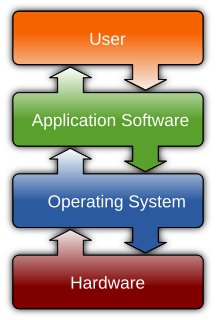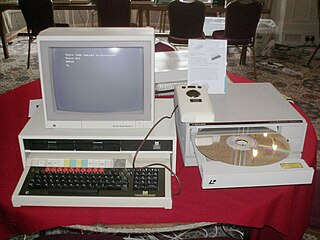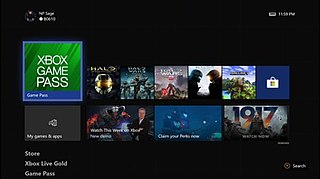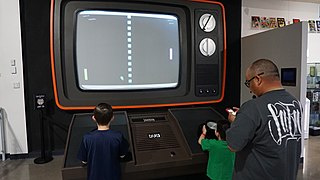
Computer software, or simply software, is a collection of data or computer instructions that tell the computer how to work. This is in contrast to physical hardware, from which the system is built and actually performs the work. In computer science and software engineering, computer software is all information processed by computer systems, programs and data. Computer software includes computer programs, libraries and related non-executable data, such as online documentation or digital media. Computer hardware and software require each other and neither can be realistically used on its own.

A macro in computer science is a rule or pattern that specifies how a certain input sequence should be mapped to a replacement output sequence according to a defined procedure. The mapping process that instantiates (transforms) a macro use into a specific sequence is known as macro expansion. A facility for writing macros may be provided as part of a software application or as a part of a programming language. In the former case, macros are used to make tasks using the application less repetitive. In the latter case, they are a tool that allows a programmer to enable code reuse or even to design domain-specific languages.
Software testing is an investigation conducted to provide stakeholders with information about the quality of the software product or service under test. Software testing can also provide an objective, independent view of the software to allow the business to appreciate and understand the risks of software implementation. Test techniques include the process of executing a program or application with the intent of finding software bugs, and verifying that the software product is fit for use.

A thin client is a lightweight computer that has been optimized for establishing a remote connection with a server-based computing environment. The server does most of the work, which can include launching software programs, crunching numbers, and storing data. This contrasts with a fat client or a conventional personal computer; the former is also intended for working in a client–server model but has significant local processing power, while the latter aims to perform its function mostly locally.

A raster image processor (RIP) is a component used in a printing system which produces a raster image also known as a bitmap. Such a bitmap is used by a later stage of the printing system to produce the printed output. The input may be a page description in a high-level page description language such as PostScript, PDF, or XPS. The input can be or include bitmaps of higher or lower resolution than the output device, which the RIP resizes using an image scaling algorithm.
IBM PC compatible computers are computers similar to the original IBM PC, XT, and AT, able to use the same software and expansion cards. Such computers used to be referred to as PC clones, or IBM clones. They duplicate almost exactly all the significant features of the PC architecture, facilitated by IBM's choice of commodity hardware components and various manufacturers' ability to reverse engineer the BIOS firmware using a "clean room design" technique. Columbia Data Products built the first clone of the IBM personal computer by a clean room implementation of its BIOS.

In computer software, an application binary interface (ABI) is an interface between two binary program modules; often, one of these modules is a library or operating system facility, and the other is a program that is being run by a user.
In computing, cross-platform software is computer software that is implemented on multiple computing platforms. Cross-platform software may be divided into two types; one requires individual building or compilation for each platform that it supports, and the other one can be directly run on any platform without special preparation, e.g., software written in an interpreted language or pre-compiled portable bytecode for which the interpreters or run-time packages are common or standard components of all platforms.
An anti-pattern is a common response to a recurring problem that is usually ineffective and risks being highly counterproductive. The term, coined in 1995 by Andrew Koenig, was inspired by a book, Design Patterns, which highlights a number of design patterns in software development that its authors considered to be highly reliable and effective.
To be used efficiently, all computer software needs certain hardware components or other software resources to be present on a computer. These prerequisites are known as (computer) system requirements and are often used as a guideline as opposed to an absolute rule. Most software defines two sets of system requirements: minimum and recommended. With increasing demand for higher processing power and resources in newer versions of software, system requirements tend to increase over time. Industry analysts suggest that this trend plays a bigger part in driving upgrades to existing computer systems than technological advancements. A second meaning of the term of System requirements, is a generalisation of this first definition, giving the requirements to be met in the design of a system or sub-system. Typically an organisation starts with a set of Business requirements and then derives the System requirements from there.
Test-driven development (TDD) is a software development process that relies on the repetition of a very short development cycle: requirements are turned into very specific test cases, then the software is improved to pass the new tests, only. This is opposed to software development that allows software to be added that is not proven to meet requirements.
Hardware abstractions are sets of routines in software that emulate some platform-specific details, giving programs direct access to the hardware resources.
The Xbox Development Kit (XDK) is a software development kit created by Microsoft used to write software for the Xbox gaming system. The XDK includes libraries, a compiler, and various tools used to create software for the Xbox. The XDK has the option to integrate itself into Microsoft Visual Studio 2002 or 2003. This is needed if one wants to develop applications or games for the Xbox. The XDK also includes a tool to record in-game footage, which has been widely used to create high-quality screenshots and trailers.
In computing, a clone is a hardware or software system that is designed to function in the same way as another system. A specific subset of clones are remakes, which are revivals of old, obsolete, or discontinued products.

Digital obsolescence is a situation where a digital resource is no longer readable because of its archaic format: the physical media, the reader, the hardware, or the software that runs on it is no longer available.
Application Virtualization is software technology that encapsulates computer programs from the underlying operating system on which it is executed. A fully virtualized application is not installed in the traditional sense, although it is still executed as if it were. The application behaves at runtime like it is directly interfacing with the original operating system and all the resources managed by it, but can be isolated or sandboxed to varying degrees.
MapInfo Pro is a desktop geographic information system (GIS) software product produced by Pitney Bowes Software and used for mapping and location analysis. MapInfo Pro allows users to visualize, analyze, edit, interpret, understand and output data to reveal relationships, patterns, and trends. MapInfo Pro allows users to explore spatial data within a dataset, symbolize features, and create maps.
The Xbox 360 system software or the Xbox 360 Dashboard is the updateable software and operating system for the Xbox 360. It resides on a 16 MB file system and has access to a maximum of 32 MB of the system's memory. The updates can be downloaded from the Xbox Live service directly to the Xbox 360 and subsequently installed. Microsoft has also provided the ability to download system software updates from their respective official Xbox website to their PCs and then storage media, from which the update can be installed to the system.

In computing, an emulator is hardware or software that enables one computer system to behave like another computer system. An emulator typically enables the host system to run software or use peripheral devices designed for the guest system. Emulation refers to the ability of a computer program in an electronic device to emulate another program or device. Many printers, for example, are designed to emulate Hewlett-Packard LaserJet printers because so much software is written for HP printers. If a non-HP printer emulates an HP printer, any software written for a real HP printer will also run in the non-HP printer emulation and produce equivalent printing. Since at least the 1990s, many video game enthusiasts have used emulators to play classic arcade games from the 1980s using the games' original 1980s machine code and data, which is interpreted by a current-era system.

The Xbox One system software, sometimes called the Xbox OS, is the operating system for the eighth-generation home video game console, Xbox One. It is a Microsoft Windows-based operating system using the Hyper-V virtual machine monitor and contains separate operating systems for games and applications that can run on the console. It is located on the internal HDD for day-to-day usage, while also being duplicated on the internal NAND storage of the console for recovery purposes and factory reset functionality.












